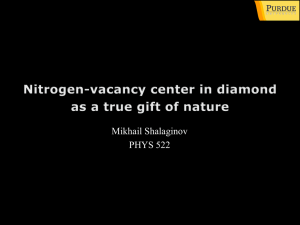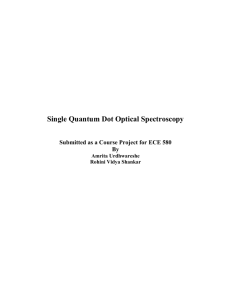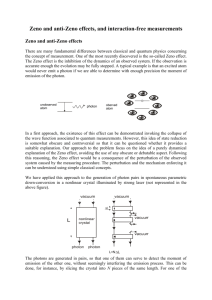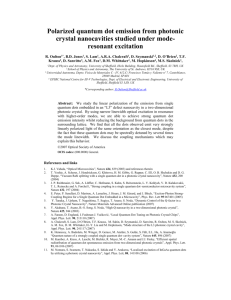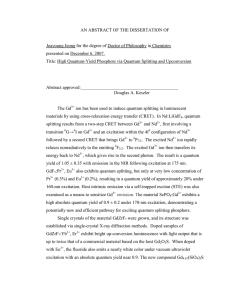Slides
advertisement
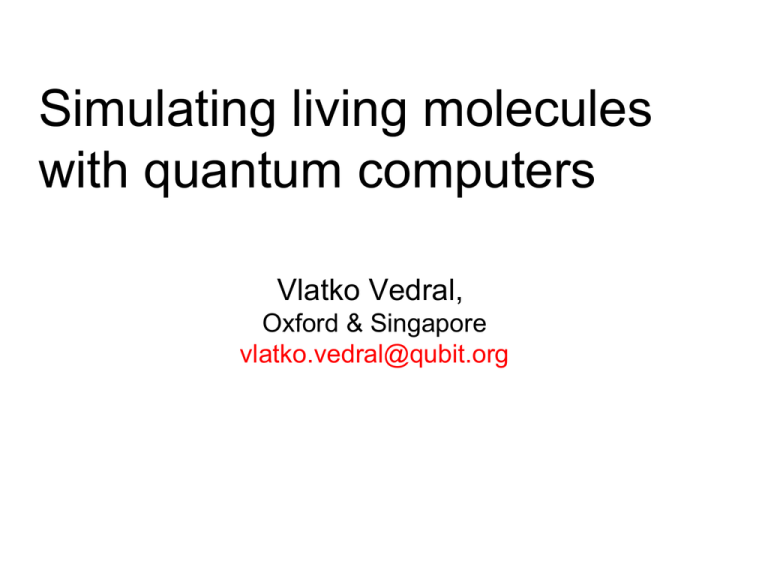
Simulating living molecules with quantum computers Vlatko Vedral, Oxford & Singapore vlatko.vedral@qubit.org Talk Outline A discussion regarding reductionism; Quantum effects in biology; Cold atoms quantum computers; Simulating energy transfer with quantum computers; Simulating life? In collaboration with… Ross Dorner, John Goold, Libby Heaney, Felix Pollock, Felix Binder, Tristan Farrow, Agata Checinska Mile Gu, Mark Williamson Discussions with: Martin Aulbach, Oscar Dahlsten, Andrew Garner, Kavan Modi, Giovanni Vacanti. Funding: Ministry of Education and National Science Foundation, Singapore, Leverhulme Trust, Templeton Foundation, James Martin School (Oxford). Reductionism or not? Macroscopic laws are compatible with the microscopic ones, but can they be fully derived from them? “Everything is either Physics or Stamp Collecting” Rutherford "The ability to reduce everything to simple fundamental laws does not imply the ability to start from those laws and reconstruct the universe.” –”More is Different” Science 1972 “At each stage, entirely new laws and generalisations are necessary, requiring inspiration and creativity.” Anderson Smallest Clock Peter Pesic, 1993 Eur. J. Phys. 14, 90 𝒍= 𝒉𝑻 𝑴 (Wigner) E-coli: 𝒍 = 𝟎. 𝟑𝝁𝒎, 𝐦 = 𝟖𝒙𝟏𝟎−𝟏𝟑 𝒈, 𝑻 ~𝟓𝟎𝒎𝒊𝒏𝒔 Reflects Schroedinger’s beliefs in “What is life?” Can we Derive Biological Laws? k=3 Any averaging Macroscopic Properties of the Periodic Ising Lattice at Ground State are in general, undecidable. Towards Quantum Simulations of Biological Information Flow Interface Focus Theme Issue `Computability and the Turning centenary' Ross Dorner, John Goold and VV Quantum coherent contributions in biological electron transfer Ross Dorner, John Goold, Libby Heaney, Tristan Farrow, VV Electron transfer in biology • The basis of all oxidation-reduction reactions in an organism; photosynthesis, vision, respiration... • Current/future technologies: Molecular electronic devices, organic LEDs Figure: M. Brownlee, Nature 414, 813 (2001) Respiratory complex I Left:. L. A. Sazanov, Biochemistry, 46, 2275 (2007). Right: J. Hirst, Biochem. J., 425, 327 (2010). Marcus theory Holstein Hamiltonian Room temperature emission from Respiratory Complex I (RCI) Arc Lamp emission RC I emission: FMN + FeS •Optical excitation using arc lamp ramped from λ = 350 to 550 nm 3.0x10 1.5x10 Exci 550 tatio 1.0x10 500 n wa 5.0x10 450 ngth vele 0.0 400 350 [nm] 600 550 500 Emis sion 450 w 400 th [nm g n e l ave ] 5 5 4 5 [arb. u.] 2.0x10 5 Intensity 2.5x10 5 •RC-I aliquot concn. 1mg/ml in MOPS (at RTP) •A grating spectrometer was used to analyse the emission then recorded with a Silicon CCD array. •Sharp rise in emission intensity in the excitation range λ = 350 to 450 nm, peaking at 410nm. •This coincides with the wavelength range where the FeS clusters and the FMN molecule in RC I absorb strongly. •Low RC I absorption of excitation wavelengths above 450nm , where most the emission signal is the contribution from arc lamp. Phonon frequency at Room Temperature •RC I concn. of 2.5 mg/ml in MOPS solution Intensity [arb. u.] 29.4 nm 1.0 Absorption Emission Lorentzian Fit •Room temperature excitation using arc lamp centred λ = 389.5nm; Grating spectrometer was used to select the excitation line (FWHM ~12nm) • Absorption measured with Perkin-Elmer spectrometer •Red-shifted emission spectrum from RC I (red curve) with respect to the absorption spectrum (blue curve). 0.5 •Stokes shift => approximate phonon 0.0 380 400 420 440 460 480 500 520 540 560 frequency Wavelength [nm] •Multiple Lorentzian peak fitting => wavelength difference estimated between the most intense peak in the two curves Parameters • On-site energies from reduction potential data1 • Vibronic coupling strength from DFT simulations of inner sphere reorganisation energy2: g = 10 – 30 THz • Vibronic frequencies from NRVS, resonance Raman spectroscopy and DFT2: ω = 5 - 10 THz • Tunnelling rates fitted from DFT simulations of in situ electron tunnelling within RC-I1: t = 1 - 10 GHz 1. T. Hayashi and A. A. Stuchebrukhov, PNAS 45, 19157 (2010). 2. D. Mitra et al, Biochem. US. 50, 5220 (2011) Can we simulate the salient aspects of a biological system in a tunable laboratory setup? Ultra-cold atoms as open system quantum simulators A trapped single ion inside a Bose Einstein Condensate C. Zipkes, S. Palzer, C. Sias and M. Kohl Nature. 464, 388 (2010) Polaron Problem C.H. Wu, A. Sommer, and A.W. Zwierlien PRL. 464, 102 230402 (2011) Greiner Lab – Harvard 2010 Bloch Lab – MPQ 2011 Simulation of Holstein Hamiltonian With Two Component ultra cold atomic mixtures Dieter Jaksch Group Polaron Physics in Optical Lattices Phys. Rev. A 76, 011605(R) (2007) Transport of strong-coupling polarons in optical lattices New J. Phys. 10, 033015 (2008) Trap single impurity on a lattice potential immersed in an auxiliary BEC! Simulation of Biological Electron Transport Tune interactions and correlation functions of auxiliary BEC bath to simulate noise Properties of living systems: Homeostasis: Regulation of the internal environment to maintain a constant state; Organization: Being structurally composed of one or more cells, which are the basic units of life. Metabolism: Transformation of energy by converting chemicals and energy into cellular components and decomposing organic matter. Growth: Maintenance of a higher rate of anabolism than catabolism. A growing organism increases in size in all of its parts, rather than simply accumulating matter. Adaptation: The ability to change over a period of time in response to the environment. Reproduction: The ability to produce new individual organisms The Colloid and the Crystal (Joseph Wood Krutch) No wonder that enthusiastic biologists in the nineteenth century, anxious to conclude that there was no qualitative difference between life and chemical processes, tried to believe that the crystal furnished the link, that its growth was actually the same as the growth of a living organism. But excusable though the fancy was, no one, I think, believes anything of the sort today. Protoplasm is a colloid and the colloids are fundamentally different from the crystalline substances. Instead of crystallizing they jell, and life in its simplest known form is a shapeless blob of rebellious jelly rather than a crystal eternally obeying the most ancient law. Living Systems = Maxwell’s demons Jacques Monod “Chance and Necessity” (1970) (Democritus, "Everything existing in the universe is the fruit of chance and necessity.“) Questions Are biomolecules capable of coherent quantum behaviour? Are quantum effects just deliberately suppressed or is there any advantage in having a fully quantum energy and matter transport? How far can quantum computers simulate bio-molecules? Can we understand laws of chemistry and biology as being consequencs of microsopic quantum physics? (Do physical facts fix all facts?) Can we build living systems bottom up?






